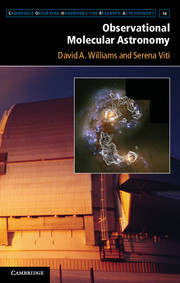
-
Select format
-
- Publisher:
- Cambridge University Press
- Publication date:
- 05 December 2013
- 25 November 2013
- ISBN:
- 9781139087445
- 9781107018167
- Dimensions:
- (228 x 152 mm)
- Weight & Pages:
- 0.48kg, 184 Pages
- Dimensions:
- Weight & Pages:
You may already have access via personal or institutional login
Book description
Molecular line emissions offer researchers exciting opportunities to learn about the evolutionary state of the Milky Way and distant galaxies. This text provides a detailed introduction to molecular astrophysics and an array of useful techniques for observing astronomical phenomena at millimetre and submillimetre wavelengths. After discussing the theoretical underpinnings of molecular observation, the authors catalogue suitable molecular tracers for many types of astronomical regions in local and distant parts of the Universe, including cold gas reservoirs primed for the formation of new stars, regions of active star formation, giant photon-dominated regions and near active galactic nuclei. Further chapters demonstrate how to obtain useful astronomical information from raw telescope data while providing recommendations for appropriate observing strategies. Replete with maps, charts and references for further reading, this handbook will suit research astronomers and graduate students interested in broadening their skill to take advantage of the new facilities now coming online.
Reviews
‘This book is an excellent introduction to the field of molecular line astrophysics. Williams and Viti cover the range of astrophysical conditions that can be probed, and the most useful molecules and transitions. The expositions are lucid, and each chapter directs the reader to papers and books for further study, and to websites where up-to-date molecular data are available. Observational Molecular Astronomy will be a valuable guide to both graduate students and researchers.'
Bruce T. Draine - Princeton University
‘This handbook provides everything needed to understand molecular astrochemistry - it will prove useful to both observers and theorists alike. It covers all of the topics a modern researcher needs to know in order to carry out observations of molecules in space, and then to reduce and analyse those observations. It also explains all aspects of molecular spectroscopy from choosing the correct molecule to observe, to calculating the physical parameters of the object being observed. All environments are discussed, from nearby clouds to distant galaxies. I am sure that this will become the must-have handbook for all researchers in this field, from new graduate students to seasoned veterans.'
Derek Ward-Thompson - University of Central Lancashire
'I would recommend that anyone embarking on a career in radio, microwave, or submillimetre astronomy and wondering what to do, why to do it, and how to do it, should own this book … it is a book that will not languish untouched on a bookshelf, but will be eagerly and often returned to and will become well thumbed.'
Source: The Observatory
Contents
-
1 - Introduction
pp 1-15 -
-
- You have access
- Export citation
-
Metrics
Altmetric attention score
Full text views
Full text views help Loading metrics...
Loading metrics...
* Views captured on Cambridge Core between #date#. This data will be updated every 24 hours.
Usage data cannot currently be displayed.
Accessibility standard: Unknown
Why this information is here
This section outlines the accessibility features of this content - including support for screen readers, full keyboard navigation and high-contrast display options. This may not be relevant for you.
Accessibility Information
Accessibility compliance for the PDF of this book is currently unknown and may be updated in the future.


